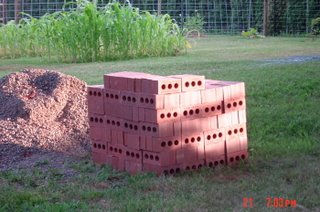It seems like most of the world is in a heat wave these days. Maybe it’s global warming, maybe only temporary. In any case, it’s got us thinking about time, labor and water use. Seven Trees is embarking on a research mission:
1. Find vegetable cultivars that can either do well in the heat (i.e. less water and fast harvest) or cultivars that can cope with damp & chilly weather (i.e. plant & harvest them before full summer hits). Hopefully we can find some that are developed for the far north, where the growing season is short. With the right varieties, we could plant in March (with help from row covers, greenhouse, cloches) and harvest in June. We also need to look into using the greenhouse better. Maybe try melons or the more heat-loving peppers in it.
2. Improve our water collection & distribution systems. Hand watering is fine when
you’re talking about a few adorable sprouts, between plentiful rain showers. It’s a whole n’other story when a gang of rowdy tomatoes and zukes are overtaking the entire acre, rioting for more more more water in 100 degree heat. We looked at methods used in countries like Kenya. Low input, low tech like bucket drip irrigation systems. Basically 5 gallon buckets hung high enough to push water through drip tapes in the garden beds. You fill them once a day and let gravity do the work. We really want to avoid installing anything that depends on the local water association, since rates will always rise, and rationing (voluntary now) is always looming. Part of our infrastructure goal is to set up a tank farm (a series of connected rain barrels) near the house, with the overflow routed through a culvert and into an underground cistern. The cistern will be in a paddock near the garden, and a hand pump should give enough lift to fill buckets with. The entire set-up should give us from 1000-1500 gallon rainwater storage capacity, depending on the size of cistern we put in.
3. Look at permaculture plants. Fruiting trees, bushes, perennials, that are cold-hardy and drought-tolerant once established. There are some likely candidates called sea berry, honey berry, wolfberry and hardy kiwi, to name a few. Once they were past their first year, they would rarely need watering and supposedly don’t have pest or disease problems in our area. Then we’d always have a source of fresh produce, no matter what conniptions the climate went through.
We also bought 300 bricks for .30 each at a closeout sale. These will be the edging for the herb bed we're digging along the front fenceline, 2 feet wide and 70 feet long.

p.s. If any generous benefactor wants to contribute $5000 for us to have a well drilled, we'd reward you with eggs and produce and copious homebrew!

No comments:
Post a Comment